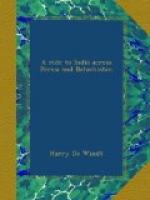[Illustration: PERSIAN DANCING-GIRL]
The Shah’s greatest failing is, perhaps, vacillation. He is constantly changing his mind, on trifling matters chiefly, for his northern neighbours take care that he is more consistent in affairs of state. Two or three times, between his visits to Europe in 1871 and 1889, he has started with great pomp and a large retinue for the land of the “Farangi,” but, on arrival at Resht, has returned to Teheran, without a word of warning to his ministers, or apparent reason for his sudden change of plans. These “false starts” became a recognized thing after a time, and when, in 1888, his Majesty embarked on his yacht and set sail for Baku, it came as a surprise, pleasant or otherwise, to his subjects at Teheran. The final undertaking of the journey may have been advised by his astrologers, for the Shah is intensely superstitious, and never travels without them. Nor will he, on any account, start on a journey on a Friday, or the thirteenth day of the month.
The palace of Teheran is, seen from the outside, a shapeless, ramshackle structure. The outside walls are whitewashed, and covered with gaudy red and blue pictures of men and horses, the former in modern military tunics and shakos, the latter painted a bright red. The figures, rudely drawn, remind one of a charity schoolboy’s artistic efforts on a slate, but are somewhat out of place on the walls of a royal residence. The interior of the “Ark,” as it is called, is a pleasant contrast to the outside, although even here, in the museum, which contains some of the finest gems and objets d’art in the world, the various objects are placed with singular disregard of order, not to say good taste. One sees, for instance, a tawdrily dressed mechanical doll from Paris standing next to a case containing the “Darai Nor,” or “Sea of Light,” a magnificent diamond obtained in India, and said to be the largest yet discovered, though somewhat inferior in quality to the “Koh-i-noor.” A cheap and somewhat dilapidated cuckoo-clock and toy velocipede flank the famous globe of the world in diamonds and precious stones. This, the most costly and beautiful piece of workmanship in the place, is about eighteen inches in diameter, and is said to have cost eight millions of francs. The different countries are marked out with surprising accuracy and detail,—Persia being represented by turquoises, England by diamonds, Africa by rubies, and so on, the sea being of emeralds.
The museum itself is about sixty feet in length by twenty-five feet broad, its ceiling composed entirely of looking-glasses, its parquet flooring strewn with priceless Persian rugs and carpets. Large oil-paintings of Queen Victoria, the Czar of Russia, and other sovereigns, surround the walls, including two portraits of her Majesty the Ex-Empress Eugenie. It would weary the reader to wade through a description of the Jade work and cloisonne, the porcelain of all countries, the Japanese works of art in bronze and gold, and last, but not least, the cut and uncut diamonds and precious stones, temptingly laid out in open saucers, like bonbons in a confectioner’s shop. The diamonds are perhaps the finest as regards quality, but there is a roughly cut ruby surmounting the imperial crown, said to be the largest in the world.




